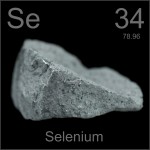 I found this Appendix N pseudoscience in A. Merritt’s 1918 book The Moon Pool:
I found this Appendix N pseudoscience in A. Merritt’s 1918 book The Moon Pool:
My theory is that the moon rock is of some composition sensitive to the action of Moon rays; somewhat as the metal selenium is to sun rays. […] When the light strikes them they release the mechanism that opens the slab, just as you can open doors with sunlight by an ingenious arrangement of selenium-cells.
Now I didn’t know anything about selenium except vaguely that it’s probably an element. Maybe you know more than me. Maybe you know that it was discovered in 1817, named after the moon, and used in light sensors from the 1870s until the 1970s. Maybe you know that its few commercial uses nowadays include glassblowing and as an ingredient in baby formula. Well, you’re very smart. I had to hit wikipedia to learn all that.
Here’s why selenium is a nice drop-in in a D&D game.
It sounds familiar and scientific, without having any specific connotations to most players (unless your players are all smarter than me too). It’s a little more technological-sounding than the traditional D&D magic materials (adamantium, mithril), and so it matches well with the strangely scientific bent that’s demonstrated by D&D dungeon builders, with their elevators, gas traps, and other automatic devices. Its use is an ancient secret of a bygone empire.
It’s steampunk. It was exciting during the Victorian era: Alexander Graham Bell used it in a photophone, which is a largely forgotten 1870’s version of fiberoptics, and it was still cool in 1918 when Merritt was writing. Like all great steampunk technologies, it’s been superseded by other technologies. (Silicon is a more efficient semiconductor, and polyvinylcarbazol a more efficient photoconductor, than selenium.)
It’s got a cool name. Selene is the Greek moon goddess’s name that also gave Selune her name. “Selenium” suggests some moonlight-drenched stone, maybe mined on the moon, maybe holy to its goddess, that calls to the heavens. It’s convenient that, in real life as in Merrit’s horror fantasy, it can be used to drive sun-powered (or moon-powered) devices.
OK, how do you use it in D&D?
In my last game session, the players captured a giant squid space ship, piloted by mind flayers, with a cargo of selenium in its belly. The PCs sold it to starfaring elves. The elves alloy it with mithril to make +1 mithril weapons. There’s a catch: selenium swords are sensitive to sunlight the same way drow weapons are, and they’re prone to damaging “sun rust”. (This is a further development of an idea I had before.
You could also use it the way selenium is used in real life, or in The Moon Pool, except magicked up: a selenium sensor can cast a spell under specific light conditions just the way a Magic Mouth can speak words under specific conditions. This ties into another idea I’ve blogged about, an electrum mirror, but with a different metal.
Selenium could be used to make magic items that only function in moonlight. A selenium sword that’s normal during the day and a +1 glowing sword in moonlight is a nice minor magic item that’ll be valuable to low-level characters.
Throw a pinch of selenium dust in the air and the light of a full moon shines down, even in a dark dungeon. This could be useful for banishing shadows, spotting werewolves, or summoning fairy creatures.
Real life selenium is poisonous, but I bet that D&D adventurers carry little vials of selenium powder (“moon dust”). A mouthful of this stuff turns you into a fey creature, which means you’re immune to charm and don’t need to sleep. You don’t need rest either: you’re immune to the effects of exhaustion for a full day. You can hustle all night and day if you have to. Over good roads, you might be able to cover 200 miles. Disadvantage: your blood runs thin. Every time you take an injury, you take 1d4 extra damage. Furthermore, after 24 hours, the exhaustion catches up to you.
Tags: everybook








As a chemist, I approve this post!
Overdoses of selenium can certainly occur, and happens occasionally with poorly made supplements (search for FDA selenium recall). Side effects include lack of interest in eating, deformed fingernails, weight loss and possible joint stiffness.
Selenium is below sulphur (or sulfur) in the periodic table, and above tellurium. Accidental ingestion of tellurium salts can give rise to a garlic like stench (search for tellurium breath), so perhaps that would be a “side effect” as well.
You forget, of course, selenium sulfide shampoo (Selsun Blue) for dandruff. I actually got a stronger version prescribed for sebaceous dermatitus. Worked like a charm. Which means selenium could be an important element in keeping mummies from flaking away, perhaps even as an ingredient in the spells to bring desiccated corpses to life, or the potions that keep liches from deteriorating. If it is sufficiently hard to come by, agents of said liches, or of other practioners of necromancy, might stop at nothing if they learn you have some.
There were also waterways polluted with the stuff in Silicon Valley. High Tech is nowhere near as “clean” an industry as it is promoted to be.